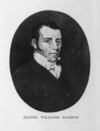ROBINAU DE PORTNEUF, PIERRE, officer in the colonial regular troops; b. 9 Aug. 1708 in Montreal, second son of René Robinau * de Portneuf and Marguerite Daneau de Muy; m. on 22 April 1748 Marie-Louise Dandonneau Du Sablé; d. 15 Nov. 1761 in the shipwreck of the Auguste off Cape Breton Island.
Pierre Robinau de Portneuf is mentioned in 1729 as a cadet in the colonial regular troops at Michilimackinac. On 1 April 1733 he was promoted second ensign, and on 1 Oct. 1740 he was made an ensign on the active list in Louisiana. On 15 April 1750 the minister of Marine, Rouillé, consenting to a request made by Governor La Jonquière [Taffanel] and Intendant Bigot*, granted permission to build a small fortified post at Toronto on the shore of Lake Ontario. The authorities of the colony hoped by this means to attract the Indians in the region, probably the Mississaugas, to trade with the French and thus dissuade them from taking their furs to the English at Fort Oswego (Chouaguen). Pierre Robinau de Portneuf, who was an ensign at Fort Frontenac (Kingston, Ont.) at this time, was designated to carry out the project.
The Sieur de Portneuf set out on 20 May 1750 and reached Toronto some time later. While the necessary provisions and articles for trade were being forwarded from Montreal, he began to build the fort that was planned on the east bank of the Rivière Toronto (Humber River), near its mouth. Within two months a warehouse and a stockade were put up. Trade with the Indians at Fort Toronto proved successful, and by 17 July a shipment of furs worth 18,000 livres had been sent to Montreal. This result surpassed expectations. On 20 August the governor wrote to the minister to acquaint him of the success and to inform him that he intended to build a new and larger fort “at the point of the peninsula called La Baye” (about a league to the east of the Humber River). He recommended the Sieur de Portneuf for this new project. Recalling the reasons for building the first post, he noted that they were more than ever valid. Moreover he suggested the possibility of persuading the Indians to destroy Oswego. Finally, as a good strategist, he asked the minister’s permission to give the name Rouillé to the new fort. Work was begun in the autumn of 1750 and went ahead throughout the winter. The fort was virtually finished in April 1751, when the Sieur de Portneuf returned from Fort Frontenac, where, it seems, he had spent the winter. He was in command at Fort Toronto, as it was still called, during the 1751 trading season and returned to Fort Frontenac in the autumn. Early in 1752 he was replaced as commandant of Fort Toronto by Thomas Robutel de La Noue.
After that the Sieur de Portneuf fades somewhat from the scene. In 1756 he was appointed commandant of Fort de la Presqu’île (Erie, Pa.). The following year he was promoted captain. He played an active role in the engagements in the Ohio valley during the Seven Years’ War. When Fort Niagara (near Youngstown, N.Y.) was under attack in 1759, he was busy at Fort de la Presqu’île rallying the Indians of the west. After Fort Niagara surrendered, he sent an emissary under a flag of truce to William Johnson*, set fire to Fort de la Presqu’île, and went to Detroit, where he surrendered to the English. In October 1761 he sailed from Quebec on the Auguste for France, perhaps with the hope of making a new career for himself there. A vain hope: one month later he was among the 113 passengers and crew members who perished when the ship sank off Cape Breton Island.
AN, Col., D2C, 222/2, p.177 (PAC transcript). É.-J. Auclair, Les de Jordy de Cabanac, histoire d’une ancienne famille noble du Canada (Montréal, 1930), passim. Frégault, François Bigot, II, 22. P. J. Robinson, Toronto during the French régime . . . (Toronto, 1933), passim. Désiré Girouard, “Le fort de Toronto,” BRH, V (1899), 137–40. É.-Z. Massicotte, “Les Montréalais et les deux forts de Toronto,” BRH, XXXIX (1933), 259–66.
© 1974–2024 University of Toronto/Université Laval
Cite This Article
Jean-Pierre Asselin, “ROBINAU DE PORTNEUF, PIERRE,” in Dictionary of Canadian Biography, vol. 3, University of Toronto/Université Laval, 2003–, accessed April 23, 2024, http://www.biographi.ca/en/bio/robinau_de_portneuf_pierre_3E.html.
The citation above shows the format for footnotes and endnotes according to the Chicago manual of style (16th edition). Information to be used in other citation formats:
| Permalink: | http://www.biographi.ca/en/bio/robinau_de_portneuf_pierre_3E.html |
| Author of Article: | Jean-Pierre Asselin |
| Title of Article: | ROBINAU DE PORTNEUF, PIERRE |
| Publication Name: | Dictionary of Canadian Biography, vol. 3 |
| Publisher: | University of Toronto/Université Laval |
| Year of publication: | 1974 |
| Year of revision: | 1974 |
| Access Date: | April 23, 2024 |







